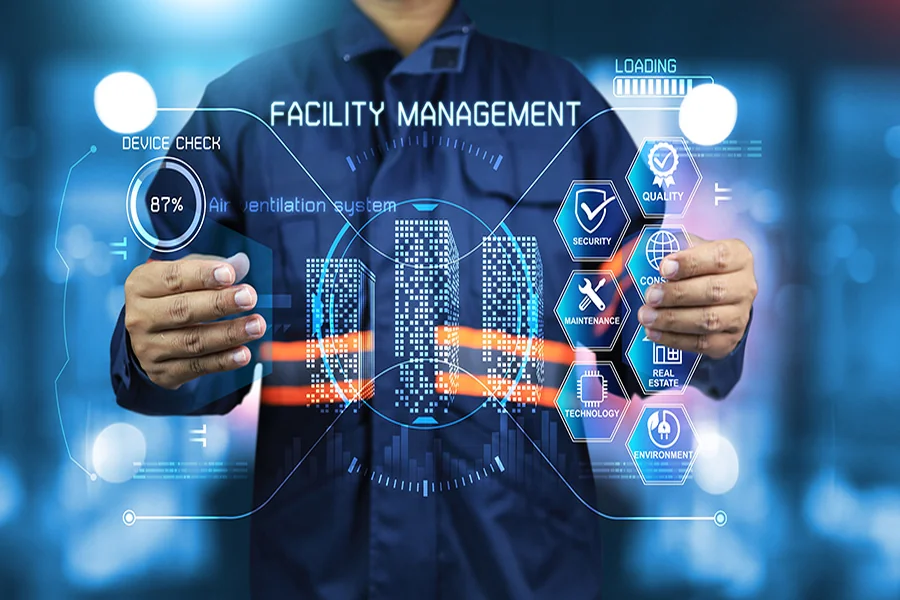How can commercial buildings run smoothly without constant disruptions? What strategies can facility managers use to keep systems operational, costs low, and tenants satisfied? In an industry where downtime and inefficiency can lead to significant financial losses, effective maintenance is critical. The answer increasingly lies in technology—specifically, Computerized Maintenance Management Systems (CMMS).
What is CMMS?
A CMMS, or Computerized Maintenance Management System, is a software platform designed to streamline the maintenance and operation of a facility’s assets. It centralizes information on equipment, schedules, maintenance histories, and work orders. By providing actionable insights, CMMS allows facility managers to proactively maintain infrastructure, reducing downtime and operational costs. Essentially, it turns reactive maintenance into a strategic, data-driven process.
Centralized Asset Management
One of the greatest challenges in managing commercial buildings is keeping track of numerous assets. From HVAC systems and elevators to lighting and security devices, commercial facilities contain hundreds, sometimes thousands, of interconnected components. CMMS software centralizes this information, creating a digital inventory of all assets. Each asset record includes manufacturer information, warranty details, maintenance schedules, and historical repairs. This centralization enables facility managers to quickly locate and evaluate equipment status, plan maintenance tasks, and make informed replacement decisions.
For example, a multi-storey office building can use CMMS to track the lifecycle of its heating and cooling systems. By having real-time access to operational data, maintenance teams can anticipate issues before they escalate, improving overall efficiency and tenant comfort.
Preventive Maintenance for Reduced Downtime
One of the core benefits of CMMS is the ability to implement preventive maintenance programs. Preventive maintenance involves performing scheduled inspections and repairs to prevent equipment failures before they occur. Without such a system, maintenance is often reactive, which can lead to costly downtime and emergency repairs.
With CMMS, facility managers can automate maintenance schedules based on usage, time, or manufacturer recommendations. For example, elevators may require monthly inspections, while HVAC filters need quarterly replacement. CMMS sends alerts when tasks are due, ensuring that no asset is overlooked. This proactive approach minimizes the risk of unexpected equipment failures, reduces emergency maintenance costs, and extends the lifespan of critical systems.
Streamlining Work Orders
Handling work requests efficiently is crucial in commercial buildings where multiple tenants rely on facility services. CMMS simplifies this process by automating work orders. Maintenance requests can be submitted digitally, categorized by urgency, and assigned to the appropriate technician. The system tracks progress, completion times, and even costs associated with each task.
Consider a retail complex with numerous shops. When a store reports a malfunctioning air conditioning unit, the CMMS instantly logs the request, assigns a technician, and records the repair timeline. Facility managers gain visibility into workload distribution, ensuring no task is delayed. Over time, the data collected helps in identifying recurring issues and optimising maintenance strategies.
Improving Energy Efficiency
Energy consumption is a significant operational cost for commercial buildings. CMMS can contribute to energy efficiency by monitoring and managing equipment usage. For instance, integrating CMMS with building automation systems allows managers to track energy consumption patterns and identify inefficiencies.
By scheduling equipment operation and ensuring timely maintenance, the system ensures that heating, ventilation, and air conditioning units operate optimally. Reduced energy waste translates into lower utility bills and a smaller environmental footprint, which can also enhance a building’s reputation for sustainability.
Enhancing Compliance and Safety
Commercial buildings are subject to stringent regulations regarding safety, fire protection, and environmental standards. CMMS supports compliance management by keeping detailed records of inspections, certifications, and maintenance activities.
For example, fire alarm systems, emergency lighting, and sprinkler systems require regular testing to meet regulatory standards. CMMS can automate reminders, document inspections, and generate compliance reports, reducing the risk of penalties or legal liabilities. Moreover, by maintaining a safe environment, facility managers protect tenants and staff while demonstrating a commitment to regulatory adherence.
Data-Driven Decision Making
Modern CMMS platforms provide analytical tools that transform maintenance data into actionable insights. Facility managers can generate reports on equipment performance, maintenance costs, and work order trends. These insights enable informed decisions regarding asset replacement, staffing, and budgeting.
For example, if a building consistently experiences HVAC failures despite preventive maintenance, data analysis may reveal the need for system upgrades rather than repeated repairs. By leveraging CMMS analytics, managers can prioritise investments that maximise efficiency, minimise downtime, and optimise long-term operational costs.
Facilitating Communication and Collaboration
Effective facility management requires seamless communication among staff, contractors, and tenants. CMMS platforms provide a centralized communication hub where work orders, maintenance updates, and asset information are accessible in real-time. Technicians can update job statuses, managers can approve purchases, and tenants can track the resolution of their requests.
This transparency fosters accountability, reduces miscommunication, and ensures that all stakeholders remain informed. In commercial buildings with multiple tenants or shared spaces, such coordination is essential for maintaining service quality and tenant satisfaction.
Scalability and Adaptability
Commercial facilities vary greatly in size, complexity, and usage. A robust CMMS is scalable, accommodating the needs of small office complexes as well as sprawling multi-use buildings. Additionally, cloud-based CMMS solutions offer remote access, allowing facility managers to monitor operations and manage maintenance from anywhere.
As a building’s portfolio expands or operational needs change, CMMS systems adapt, supporting additional assets, workflows, and users. This flexibility ensures that facility management processes remain efficient, even as the scope of operations grows.
Conclusion
The management of commercial buildings is a multifaceted challenge that demands efficiency, accuracy, and foresight. CMMS offers facility managers the tools to centralize asset information, schedule preventive maintenance, streamline work orders, improve energy efficiency, and ensure compliance. By providing actionable insights and enhancing communication, CMMS transforms facility management from a reactive task into a strategic, data-driven process.
In an era where tenants expect comfort, reliability, and sustainability, optimising facility management with CMMS is no longer optional—it’s a necessity. Implementing a CMMS system empowers commercial building operators to reduce downtime, control costs, and deliver a high-quality environment for occupants. In short, it is the cornerstone of modern, intelligent facility management.





